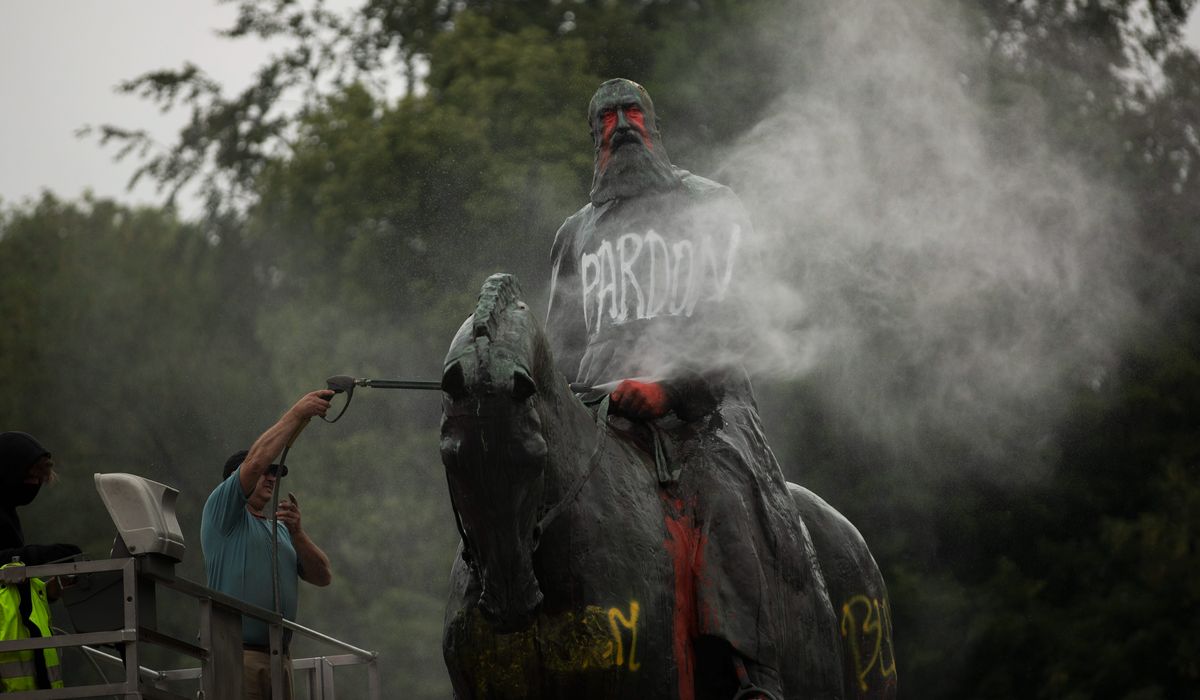George Floyd’s death at the hands of a Minneapolis police officer this summer reverberated thousands of miles to the east, where protesters in Belgium toppled a statue of a former king, Leopold II.
In Britain, meanwhile, a massive bronze statue of a philanthropist who made his money in the 17th century slave trade was hooked with a pulley, pulled to the ground and dumped in the docks by demonstrators in Bristol.
And an Oxford University college will decide early next year whether to oust Cecil Rhodes, a 19th century British imperialist, founder of the De Beers diamond firm and creator of the Rhodes Scholarship program — and seen by many as a racist who laid the groundwork for apartheid.
A Rhodes statue at the University of Cape Town in South Africa came down in 2015, and a bust of Rhodes in Cape Town was decapitated this summer.
In Canada, Sir John A. MacDonald, the country’s first prime minister, was tumbled by protesters in Montreal, angered by the treatment of Indigenous children, who were forced into residential schools, forbidden from speaking their languages, and in some cases abused to death.
America’s racial unrest of 2020 has become a worldwide reckoning, with demonstrators taking it into their own hands to conduct urban planning.
And where the targets in the U.S. are largely figures from the American Civil War or the later era of segregation, other countries are grappling with their colonial pasts or their treatment of Native populations.
“I think that every single country has specific issues that historically, if they pulled back that curtain of history, there are darker aspects of that history through the lens of today,” said Timothy P. Schmalz, an Ontario-based sculptor.
In Canada, he said, “Most of our focus is on the Indigenous people that were mishandled throughout the centuries.”
While the debate targets vary, public opinion is generally united — from Canada to the U.S. to Britain, most people don’t think very highly of the protesters tearing down statues on their own say-so.
Neither do the countries’ leaders.
British Prime Minister Boris Johnson defended the Rhodes statue at Oxford, and Canadian Prime Minister Justin Trudeau said he was “deeply disappointed” to see MacDonald’s statue pulled down.
In France, where Parisian activists splashed red paint on a statue of Jean-Baptiste Colbert, who drafted a legal framework for slavery in the French colonies, President Emmanuel Macron delivered a televised address saying his country wasn’t in the business of trying to “erase” its colonial-era history.
He said “truth” was more important than “denying who we are.”
Christopher Phelps, a historian in American studies at the University of Nottingham, said the debates “transpire within societies with distinct pasts to reckon with.”
But he said the commonalities among the countries are striking.
“Are the Cecil Rhodes memorials that arc from Oxford to South Africa, occasioning a ‘Rhodes Must Fall’ movement, really so different from Robert E. Lee statues in the United States?” he said. “Both were erected in the early 20th century at the dawn of imperialism, deliberately meant to affirm the white supremacist ideology favored by those with wealth and power then.”
Taking down a previous generation’s work is by no means a modern phenomenon.
As far back as ancient Egypt, kings were erasing predecessors. Akhenaten, a pharaoh who pioneered the idea of a monotheistic religion, had his monumental memory demolished.
And in ancient Rome, Sulla tore down statues that had been erected by Marius — and Julius Caesar had them restored.
Those deletions were made by authorities in power.
What sets much of the 2020 debate apart is the vigilante nature of some statue destruction and the breadth of successful targets. Statues that have survived years and even decades of controversy are coming down this time.
Even at the U.S. Capitol, a Robert E. Lee statue from Virginia that has stood for more than a century despite decades of controversy was ousted.
Mr. Phelps said there’s been a tipping point in the debate over statues, with a deeper public examination of who is celebrated.
“I see this as a healthy and reasonable reconsideration,” the scholar said. “As commissioned monuments, such statues are akin to architecture; just as we often knock down or overhaul buildings to make room for new forms that are more useful, so too new public art may be needed to reflect new democratic aspirations.”



















